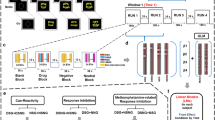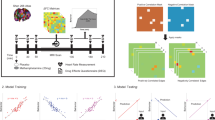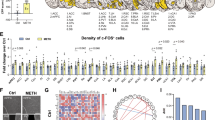Abstract
Stimulant-dependent subjects show dysfunctions in decision-making similar to those seen in subjects with ventromedial prefrontal cortex lesions. Studies of drug craving, reward association, and decision-making have implicated dysfunctions of the dorsolateral and orbitofrontal cortex as a key neural substrate in subjects with stimulant dependence. Here, a functional magnetic resonance imaging (fMRI) study was carried out to determine the relationship between decision-making dysfunction and neural activation in different prefrontal areas. This investigation tested the behavioral hypothesis that methamphetamine-dependent subjects in early sustained remission show decision-making dysfunctions that are consistent with an increased reliance on stimulus-contingent response selection. It was hypothesized that these decision-making dysfunctions are due to differences in task-related activation in the dorsolateral and ventromedial prefrontal cortex. Ten methamphetamine-dependent subjects were compared with ten age- and education-matched controls performing a two-choice prediction task and a two-choice response task during a fMRI session. Response bias, latency, and mutual information measures assessing the underlying strategies of the decision-making sequences were obtained. First, methamphetamine-dependent subjects were more influenced by the immediately preceding outcome during the two-choice prediction task relative to normal comparison subjects. Second, methamphetamine-dependent subjects activated less dorsolateral prefrontal cortex (BA 9) and failed to activate ventromedial cortex (BA 10,11) during the two-choice prediction task compared with the two-choice response task. These results support the basic hypothesis that stimulant-dependent subjects exhibit fundamental cognitive deficits during decision-making that are consistent with both orbitofrontal and dorsolateral prefrontal dysfunction.
Similar content being viewed by others
Log in or create a free account to read this content
Gain free access to this article, as well as selected content from this journal and more on nature.com
or
References
Allen TJ, Moeller FG, Rhoades HM, Cherek DR . (1998): Impulsivity and history of drug dependence. Drug Alcohol Depend. 50: 137–145
American Psychiatric Association. (1994): Diagnostic and Statistical Manual of Mental Disorders, 4th edition (DSM-IV). Washington DC, American Psychiatric Press
Bartzokis G, Lu PH, Beckson M, Rapoport R, Grant S, Wiseman EJ, London ED . (2000): Abstinence from cocaine reduces high-risk responses on a gambling task. Neuropsychopharmacology 22: 102–103
Bechara A, Damasio AR, Damasio H, Anderson SW . (1994): Insensitivity to future consequences following damage to human prefrontal cortex. Cognition 50: 7–15
Cohen MS . (1997): Parametric analysis of fMRI data using linear systems methods. Neuroimage 6: 93–103
Cox RW . (1996): AFNI: Software for analysis and visualization of functional magnetic resonance neuroimages. Computers and Biomedical Research 29: 162–173
Damasio AR, Tranel D, Damasio H . (1990): Individuals with sociopathic behavior caused by frontal damage fail to respond autonomically to social stimuli. Behav Brain Res 41: 81–94
Elliott R, Dolan RJ . (1998): Activation of different anterior cingulate foci in association with hypothesis testing and response selection. Neuroimage 8: 17–29
Elliott R, Frith CD, Dolan RJ . (1997): Differential neural response to positive and negative feedback in planning and guessing tasks. Neuropsychologia 35: 1395–1404
Elliott R, Rees G, Dolan RJ . (1999): Ventromedial prefrontal cortex mediates guessing. Neuropsychologia 37: 403–411
Ernst T, Chang L, Leonido-Yee M, Speck O . (2000): Evidence for long-term neurotoxicity associated with methamphetamine abuse: A 1H MRS study. Neurology 54: 1344–1349
Forman SD, Cohen JD, Fitzgerald M, Eddy WF, Mintun MA, Noll DC . (1995): Improved assessment of significant activation in functional magnetic resonance imaging (fMRI): Use of a cluster-size threshold. Magn Reson Med 33: 636–647
Frith CD, Friston K, Liddle PF, Frackowiak RS . (1991): Willed action and the prefrontal cortex in man: A study with PET. Proc R Soc Lond B Biol Sci 244: 241–246
Grant S, Contoreggi C, London ED . (2000): Drug abusers show impaired performance in a laboratory test of decision making. Neuropsychologia 38: 1180–1187
Green L, Myerson J and Ostaszewski P . (1999): Amount of reward has opposite effects on the discounting of delayed and probabilistic outcomes. J Exp Psychol Learn Mem Cogn 25: 418–427
Herzel H, Grosse I . (1997): Correlations in DNA sequences: The role of protein coding segments. Physical Review E 55: 800–810
Jahanshahi M, Dirnberger G . (1999): The left dorsolateral prefrontal cortex and random generation of responses: Studies with transcranial magnetic stimulation. Neuropsychologia 37: 181–190
Kim JN, Shadlen MN . (1999): Neural correlates of a decision in the dorsolateral prefrontal cortex of the macaque. Nat Neurosci 2: 176–185
Lancaster JL, Woldorff MG, Parsons LM, Liotti M, Freitas CS, Rainey L, Kochunov PV, Nickerson D, Mikiten SA, Fox PT . (2000): Automated Talairach atlas labels for functional brain mapping. Hum Brain Mapp 10: 120–131
London ED, Ernst M, Grant S, Bonson K, Weinstein A . (2000): Orbitofrontal cortex and human drug abuse: Functional imaging. Cereb Cortex. 10: 334–342
McCann UD, Wong DF, Yokoi F, Villemagne V, Dannals RF, Ricaurte GA . (1998): Reduced striatal dopamine transporter density in abstinent methamphetamine and methcathinone users: Evidence from positron emission tomography studies with [11C]WIN-35,428. J Neurosci 18: 8417–8422
Monterosso J, Ainslie G . (1999): Beyond discounting: Possible experimental models of impulse control. Psychopharmacology (Berl.) 146: 339–347
Nobre AC, Coull JT, Frith CD, Mesulam MM . (1999): Orbitofrontal cortex is activated during breaches of expectation in tasks of visual attention. Nat Neurosci 2: 11–12
Norusis MJ . (1990): SPSS Base System User's Guide. Chicago, SPSS Inc.
O'Doherty J, Rolls ET, Francis S, Bowtell R, McGlone F, Kobal G, Renner B, Ahne G . (2000): Sensory-specific satiety-related olfactory activation of the human orbitofrontal cortex. Neuroreport 11: 893–897
O'Doherty J, Kringelbach ML, Hornak J, Andrews C, Rolls ET . (2001): Abstract reward and punishment representations in the human orbitofrontal cortex. Nat Neurosci 4: 95–102
Ornstein TJ, Iddon JL, Baldacchino AM, Sahakian BJ, London M, Everitt BJ, Robbins TW . (2000): Profiles of cognitive dysfunction in chronic amphetamine and heroin abusers. Neuropsychopharmacology 23: 113–126
Paulus MP . (1997): Long-range interactions in sequences of human behavior. Physical Review E 55: 3249–3256
Paulus MP, Geyer MA, Braff DL . (1994): The assessment of sequential response organization in schizophrenic and control subjects. Prog. Neuropsychopharmacol Biol Psychiatry 18: 1169–1185
Paulus MP, Geyer MA, Braff DL . (1996): Use of methods from chaos theory to quantify a fundamental dysfunction in the behavioral organization of schizophrenic patients. Am J Psychiatry 153: 714–717
Paulus MP, Hozack N, Zauscher B, McDowell JE, Frank L, Brown GG, Braff DL . (2001): Prefrontal, parietal, and temporal cortex networks underlie decision-making in the presence of uncertainty. Neuroimage 13: 91–100
Petry NM, Bickel WK, Arnett M . (1998): Shortened time horizons and insensitivity to future consequences in heroin addicts. Addiction 93: 729–738
Platt ML, Glimcher PW . (1999): Neural correlates of decision variables in parietal cortex. Nature 400: 233–238
Rahman S, Sahakian BJ, Hodges JR, Rogers RD, Robbins TW . (1999): Specific cognitive deficits in mild frontal variant frontotemporal dementia. Brain 122: 1469–1493
Rogers RD, Everitt BJ, Baldacchino A, Blackshaw AJ, Swainson R, Wynne K, Baker NB, Hunter J, Carthy T, Booker E, London M, Deakin JF, Sahakian BJ, Robbins TW . (1999a): Dissociable deficits in the decision-making cognition of chronic amphetamine abusers, opiate abusers, patients with focal damage to prefrontal cortex, and tryptophan-depleted normal volunteers: Evidence for monoaminergic mechanisms. Neuropsychopharmacology 20: 322–339
Rogers RD, Owen AM, Middleton HC, Williams EJ, Pickard JD, Sahakian BJ, Robbins TW . (1999b): Choosing between small, likely rewards and large, unlikely rewards activates inferior and orbital prefrontal cortex. J Neurosci. 19: 9029–9038
Rogers RD, Andrews TC, Grasby PM, Brooks DJ, Robbins TW . (2000): Contrasting cortical and subcortical activations produced by attentional-set shifting and reversal learning in humans. J Cogn Neurosci 12: 142–162
Rolls ET . (2000): The orbitofrontal cortex and reward. Cereb Cortex. 10: 284–294
Seale DA, Rapoport A . (1997): Sequential decision making with relative ranks: An experimental investigation of the “secretary problem.” Organizational Behavior & Human Decision Processes 69: 221–236
Spitzer RL, Williams JB, Gibbon M, First MB . (1992): The Structured Clinical Interview for DSM-III-R (SCID): I. History, rationale, and description. Arch Gen Psychiatry 49: 624–629
Talairach J, Tournoux P . (1988): Co-Planar Stereotaxic Atlas of the Human Brain: A 3-Dimensional Proportional System, an Approach to Cerebral Imaging. New York, Thieme Medical Publishers
Tversky A, Sattath S, Slovic P . (1988): Contingent weighting in judgment and choice. Psychol Rev 95: 371–384
Volkow ND, Fowler JS . (2000): Addiction, a disease of compulsion and drive: Involvement of the orbitofrontal cortex. Cereb Cortex. 10: 318–325
Volkow ND, Fowler JS, Wang GJ, Hitzemann R, Logan J, Schlyer DJ, Dewey SL, Wolf AP . (1993): Decreased dopamine D2 receptor availability is associated with reduced frontal metabolism in cocaine abusers. Synapse 14: 169–177
Acknowledgements
We would like to acknowledge the invaluable help of Rick Buxton and Eric Wong in supporting the fMRI experiments. This work was supported by grants from NIMH (MH R37-42228 to DLB; R21DA13186 to MPP), NARSAD (MPP), and support from the Veterans Administration via a Merit Award (MPP) and a VISN 22 MIRECC.
Author information
Authors and Affiliations
Corresponding author
Rights and permissions
About this article
Cite this article
Paulus, M., Hozack, N., Zauscher, B. et al. Behavioral and Functional Neuroimaging Evidence for Prefrontal Dysfunction in Methamphetamine-Dependent Subjects. Neuropsychopharmacol 26, 53–63 (2002). https://doi.org/10.1016/S0893-133X(01)00334-7
Received:
Revised:
Accepted:
Published:
Issue date:
DOI: https://doi.org/10.1016/S0893-133X(01)00334-7
This article is cited by
-
Prefrontal fNIRS-based clinical data analysis of brain functions in individuals abusing different types of drugs
Journal of Biomedical Semantics (2021)
-
Endocytosis-pathway polygenic scores affects the hippocampal network connectivity and individualized identification across the high-risk of Alzheimer’s disease
Brain Imaging and Behavior (2021)
-
Reconfigured functional network dynamics in adult moyamoya disease: a resting-state fMRI study
Brain Imaging and Behavior (2020)
-
Intervention Effect of Repetitive TMS on Behavioral Adjustment After Error Commission in Long-Term Methamphetamine Addicts: Evidence From a Two-Choice Oddball Task
Neuroscience Bulletin (2018)
-
Effect of three different regimens of repeated methamphetamine on rats’ cognitive performance
Cognitive Processing (2018)



